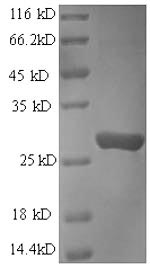Thanks for your inquiry.
1.full-length Sec16A (human species)
Reference: https://www.uniprot.org/uniprot/O15027
Sorry, the full length of the default Isoform 1 has 2179aa, we can't provide the full length, we can only provide the partial.
If you're interested in the partial protein, please let us know which region you're interested in.
Below is one of the partial proteins that we can provide for your reference:
Recombinant Human Protein transport protein Sec16A(SEC16A),partial
CSB-YP020942HU >> Yeast
CSB-EP020942HU >> E.coli
CSB-BP020942HU >> Baculovirus
CSB-MP020942HU >> Mammalian cell
Expression Region: 1943-2154aa; Partial of Isoform 4
Tag information:EP, YP, BP, MP: Tag type will be determined during the manufacturing process.
The expected tag for each expression system is listed as follows: EP, YP, BP, MP: N-terminal 6xHis-tagged
Sequence:
AYLPDDKNKSIVWDEKKNQWVNLNEPEEEKKAPPPPPTSMPKTVQAAPPALPGPPGAPVNMYSRRAAGTRARYVDVLNPSGTQRSEPALAPADFVAPLAPLPIPSNLFVPTPDAEEPQLPDGTGREGPAAARGLANPEPAPEPKLSRCSSMSSLSREVSQHFNQAPGDLPAAGGPPSGAMPFYNPAQLAQACATSGSSRLGRIGQRKHLVLN
http://www.ncbi.nlm.nih.gov/pmc/articles/PMC1805085/pdf/zmk839.pdf
This literature reports that the SEC16A (1943-2154) can react with Sec23A.






